Chatting to Ella Doran designer, photographer, and mark-maker.
Read the full interview at Material Source
Read the full interview at Material Source

Replay Ella Doran and jewellery designer Sian Evans as they discuss what we need as people and small businesses to survive and even thrive moving forward in this moment.
Moderated by Charlene C Lam, NYC-LDN content consultant and curator of The Creative Edit.

Duncan Riches interviews Ella Doran, Andrea and Patrizia of Urban Upholstery, and Sophie Thomas about their new chair ‘Clean Up Plastic Camo’ launching during Shoreditch Design Triangle 2020. Discover the story behind the Chair and how they created a new fabric using the negative back-story of plastic pollution with a new message of re-use and hope.
This podcast was recorded live on Monday 14 September 2020.
Ella Doran and Urban Upholstery join forces to showcase their stunning ‘Clean Up Plastic Camo chair’ viewable at Solid Floor East during Shoreditch Design Triangle 2020
Urban Upholstery and Ella Doran have celebrated the circular economy and material re-use and re-design by giving new life to old furniture for over 10 years.
The project started with an abandoned chair from the streets of Hackney. The chair was de-constructed back to its core frame and re-upholstered during Shoreditch Design Triangle 2018 live at The Old Bank Vault art gallery, alongside a group of school children from Shoreditch Park School.

Clean Up Plastic Camo chair Thames London.
7a Ezra Street,
London E2 7RH,
UK VIEW ON MAP
Mon - Fri 10 - 6 pm Sat 12 - 6 pm Sun 10 - 2 pm
The textile design was born from a further collaboration between Ella and Sophie Thomas.
The design depicts waste plastic collected by Sophie from beaches around the world. Together they created artful arrangements of these almost jewel-like pieces. Ella photographed them to then create the textile design, the nature of which is only revealed under close inspection.
The fabric tells the negative back-story of plastic pollution with a new message of re-use and hope.
Visit the showroom at Solid Floor during the festival to view the chair in all its splendour. The chair is available to buy as a unique one-off piece and we welcome further commissions, just get in touch.
There will be a podcast discussing the full story of the chair and the textile at 3pm on September 14th, featuring everyone involved, from Ella Doran and Sophie Thomas to Andrea and Patrizia of Urban Upholstery, as part of the Shoreditch Design Triangle podcast series.
The Multi Story Thinking Podcast unravels the mysteries of interior design.
Hosted by designer and educator Jonathan Forster the podcast takes an educational slant on the world of interior design providing an insight into the how and the why.
It includes interviews with professionals from across the spectrum of the interior design world alongside more practical discussions about techniques, processes and the professional practice of interior design.
Jonathan recently had a chat with Ella in which we discover how she set up her business after a chance meeting with a supplier, her philosophy on design and the importance of materials and processes. The challenges and opportunities of licensing. And how she got the inspiration for a project by observing the landscape and sheep!
Listen to it here
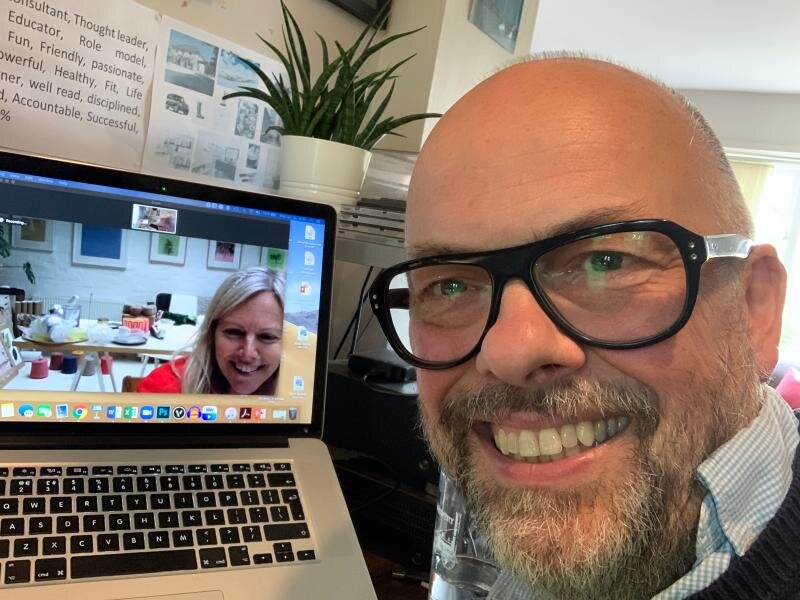
Jonathan Forster and Ella on Zoom recording the podcast!
Back in 2017, I was working on a bespoke range of merchandise for YSP, and reflecting on a residency I had undertaken with the Great Recovery (2015/16) at the RSA investigating bulky waste, you can read the full report here. After this residency, I had a strong desire to advocate and educate the public about the circular economy, which inspired me to create my biggest solo project to date - ‘Sheep to Seat, Fleece to Floor’ at Yorkshire Sculpture Park. This took me over a year to realize and to raise financial support from my sponsors, thanks to Camira Fabrics, Alternative Flooring, and Campaign for Wool, this was all made possible.
My aim was to feature the journey of British wool, culminating in an immersive room set exhibition at Yorkshire Sculpture Park. It celebrated the Park’s resources, its beauty, and the joy of creativity and collaboration. Wool is one of the most versatile, sustainable and abundant agricultural materials, and currently, it is one of the most undervalued as a commodity.

The journey of the wool for this exhibition
My objective was to create a road map for the materials and manufacturing processes and to shine a light on the principles of the Circular Economy for the Yorkshire Sculpture Park’s visitors to understand. I wanted to make visible all of the processes (shearing, scouring, spinning, dyeing and weaving) that the wool from the sheep at Yorkshire Sculpture Park had to go through in order to be made into woven textiles, blankets, tapestries, furniture, and a floor runner. All incorporating my designs inspired by the flora and fauna at the Park.
This was filmed by Paul Wyatt in real-time as the project progressed and the film, The Fabric of the Land’ was shown throughout the duration of the exhibition.
‘Where there is muck there is brass’ this is the industry’s famous saying, nothing goes to waste in the scouring plant at Haworth’s, everything extracted is taken off for re-use, the oils extracted have a multitude of uses from beauty products to Vitamin D, even the nutrient rich dust (shoddy) is used in agriculture. The shoddy in this case, was returned to the Park in early November and we planted a Rowan tree completing a full life cycle of the wool for this project.
I have so many collaborators to thank:
Starting with Retail exhibition & Programme Manager Amanda Peach, who helped me make it all happen! YSP Chief Gardner Terry Lee, and Hayley Barrett designer from Camira Fabrics, furniture designer Julian Mayor, Marketing Manager Lorna Haigh from Alternative Flooring, Peter Ackroyd From Campaign for wool, and Graham Clark & Haldi Kranich-Wood from British Wool, Tim Booth from Atlantic Yarns and, filmmaker Paul Wyatt & RSA Fellow, Tim Cox and Sheridan Coakley of Coackly Cox Furniture Manufacturers. For my wallpapers inspired by the flora of the Park, a big thank you goes to 1838 wall coverings sister company to Surface Print and to Fiona Fouhy and Susan Clarke of East London Print Makers

close up of one of my small tapestry woven piece for the exhibition
To those of you who have watched the film by Paul Wyatt, below, you will recall that I said I would return the waste wool from Haworth’s to the Park, and plant a tree. Well this week I did just that! I closed the circle on the cycle of the wool from the sheep that graze amongst the Henry Moore sculptures. I had the help of my assistant Milda and Mark Chesman one of the resident Gardner’s at YSP.

Rowan Tree ready to plant at YSP
The tree had been waiting to be planted since the closure of Giuseppe Penone’s exquisite exhibition earlier in the year. The tree designated for me was a Rowan tree also known as a Mountain Ash, due to the fact that it grows well at high altitudes and its leaves are similar to those of an ash.
It is best to plant trees from late October onwards in the UK - many experts claim this because the tree can make new roots without having to feed the leaves. The roots grow best in cool soil, therefore the winter months give the roots time to form before the leaves develop through spring to summer, thus vying for the greater share of energy to do so.
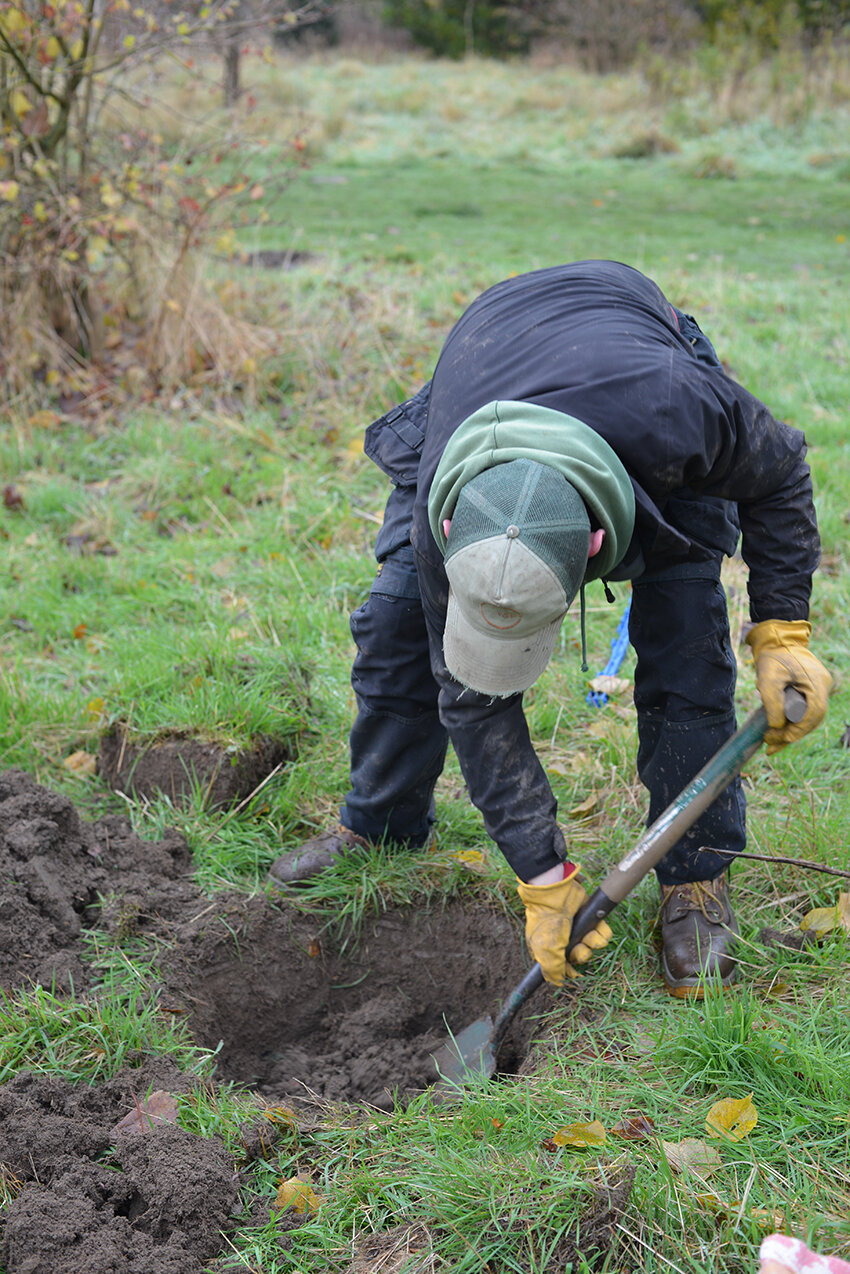
The wool dust was saved from the scouring at Haworth’s in Bradford, earlier in the Spring and returned to the ground buried with a wool sack that I made using the jacquard woven textile of my Waterlake design. You can read more about the weaving with Camira Fabrics here.


I’ve been reading a lot about sequestering carbon, and the single most effective route to do this, is to plant more trees. I personally donate to TreeSisters who are on a mission to plant millions of trees, from Mount Kenya to Cameroon, Indonesia to Mozambique to list a few, and empowering the local communities in each region to grow them. Clare Dubois is a compelling leader and speaker, you can listen to her in conversation with Jon Snow earlier in May this year here in London.

Further links to support planting trees closer to home:
Re-wilding the Scottish Highlands:
Closer to home I am thrilled to see that my borough of Hackney has a plan to plant 5000 trees in less than three years a mixture of native and non native ones.
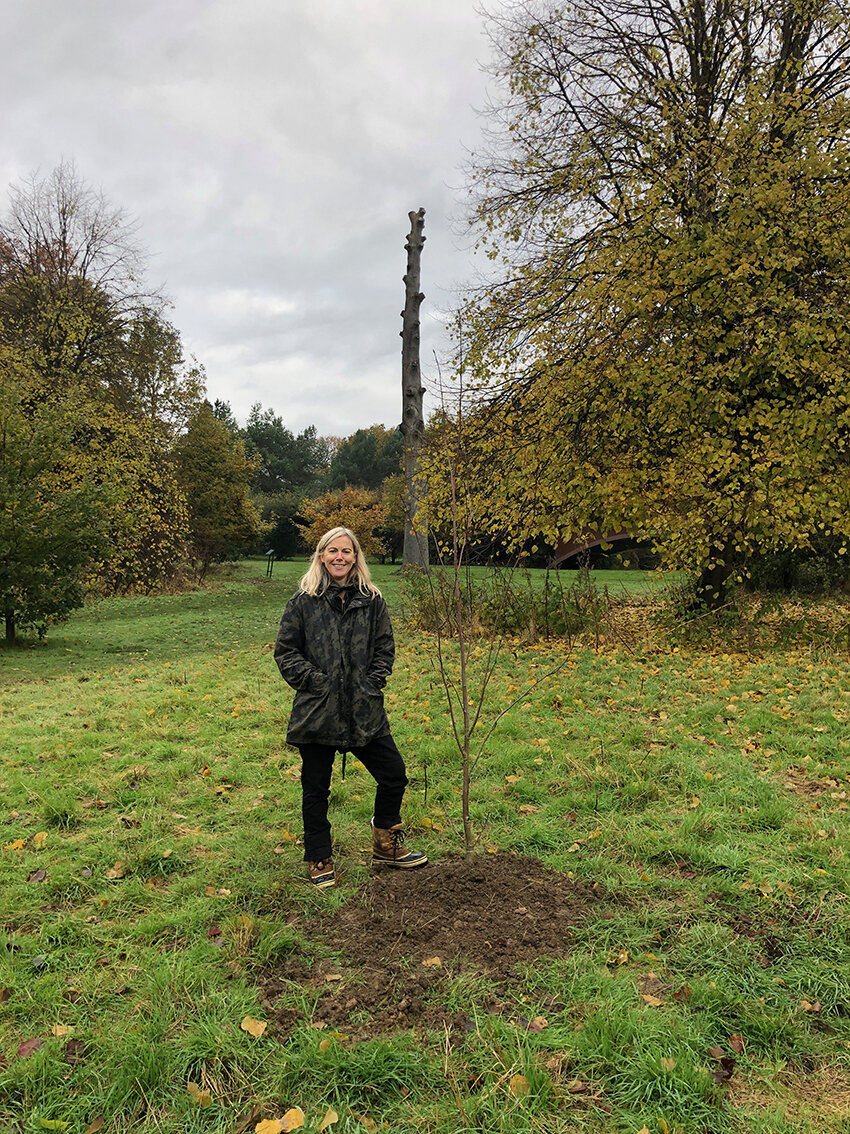
Planted! Yorkshire Sculpture Park October 2019

Photo credit: close up of Waterlake on the loom @ Camira Fabrics
For Saturday 21st ‘Working with Wool workshop’ click <a href="http://For 'Working with Wool workshop' click here for tickets
For Saturday 21st Collaboration by Design panel discussion click here for tickets
Drinks reception, and screening from 5pm until 8pm
For Sunday 22nd Communicating Your Craft: How to Tell Better Stories click here
For Sunday 22nd From Farm to Fibre – learn to weave with wool from artist Ella Doran at London Loom click here for tickets

Ella is an award-winning product and textile designer and both she and Patrizia and Andrea of Urban Upholstery have worked and experimented widely with this ‘superior’ material to make furniture, carpets, fabrics and tapestries.
During the workshop they will demonstrate how to make a floor-cushion (60x60x15cm) using recycled wool, and the infamous Survivor Fabric made by Camira which incorporates recycled and virgin wool.
They will involve you in the skilled tasks of this process: stuffing, tufting and stitching the wool. Using an antique button-making tool, you will contribute and participate by making fabric covered buttons, which will then be used in the tufting process for the cushion. All participants’ names will go in a hat for a winner to be drawn and take home the cushion made on the day!
This event is part of a series of talks and events hosted by Ella Doran ‘Collaboration by Design’: in partnership with The Creative Edit, supported by Campaign for Wool.
This is a perfect taster for complete beginners and those looking to experiment and get creative alongside learning about the provenance and story behind Ella Doran’s wool and the wider principles behind the circular economy.
Ella says
“I found this workshop with Francesca from The London Loom such a joyful experience I wanted to share it and for you to have the opportunity of working with this British wool! It’s a beautiful productive and mindful activity where you can let your creative juices flow and you come away with a cloth of your own creation. What’s not to love!”
Visit London Looms website here


Photo credit: Sheep to Seat, Fleece to Floor, 2019 (installation view). Courtesy the artist and YSP. Photo © Jonty Wilde
The last throes of June sunlight cast a bluish glow throughout the foyer of Yorkshire Sculpture Park’s visitor centre. It’s 6.30pm on a Friday and, for a gallery set remotely in the low lying hills north of the Peak District, it has attracted a large and lively crowd. Beyond the bobbing heads, Farmer Charles Platt, whose family has reared and sheared the small flock of sheep on YSP’s grounds for generations, stands alone, arms behind back, swaying on his heels, looking across at the podium where the London-based designer Ella Doran begins her speech.
“I’m incredibly nervous,” she begins…
It is unusual to find a farmer and textile designer in the same room, but this evening is about dissolving the silos in the design-to-consumer chain. Doran’s exhibition From Sheep to Seat/Fleece to Floor is the culmination of a two-year collaboration between the designer, YSP, local labourers and national manufacturers and crafts people to realise Doran’s vision of a circular design model utilising the Park’s wool – the very wool that Platt and his brother sheared last autumn – and an onsite storm-felled oak. The artworks, furniture and textiles on display here for the next three months map their journey and the values underpinning it: connectivity, appreciation and balance.
Platt seems pleased to be here if a touch out of his comfort zone. “It’s been great to be a part of it,” he says in his broad Yorkshire drawl. “I had no idea what to expect when Ella came to me talking about circular economy and using our sheep. I never know where the wool goes after we deliver it to the Wool Board.”
Being part of the project has revealed to Platt the transformation of his wool for the shop floor and the human faces behind each stage in the process. The first of these were the staff at Haworth Scouring Company to where he accompanied Doran. One of the UK’s remaining wool manufacturers, Haworth sort, scour, and comb the course, matted, yellowish hair sheared by farmers into the bright looms of soft white fibre received by design industries. It was in learning that Haworth produce zero waste during their manufacturing process, even gathering residual dusts to mix into compost soil, that Ella Doran chose wool as her choice circular material.
“The dustbin is so called because dust used to be the only thing that we threw in it until the idea of ‘waste’ became integral to the economy,” she says. “The wool manufacturing process exemplifies how ‘waste’ is a design flaw of modernity. As the old saying goes, ‘where there’s muck, there’s brass.’”
The phrase inspired one of the exhibition’s feature pieces; a wool table designed by Doran and produced by SolidWool’s Justin Floyd, crafted from offcuts of Platt’s wool. Floyd, who has been refining the process of creating solid wool since 2012, binds the wool with bio-resins to achieve a hard, water-resistant surface. The sheen on the ‘Where There’s Muck There’s Brass’ table rivals that of polished marble, as does its dappled creamy texture – only a discerning eye distinguishes the fibre flecks of undyed wool beneath the resplendent surface. To fulfil the second half of the adage, Doran had the solid wool surface framed with brass. The effect is simple yet striking, wool and brass complementing one another in an unexpected harmony of refracted light.

Photo credit: Where there’s muck there’s brass, 2019 Brass and solidwool table. Courtesy of the artist and YSP. Photo © Ella Doran.
The table is one of many manifestations of wool’s versatility exhibited at Sheep to Seat/Fleece to Floor. Doran’s floor runner, wall hangings, wallpaper, stools and designer Julian Mayor’s ‘kissing seats’ testify to the myriad uses of this country’s most abundant natural resource. The variety of techniques used to create the collection, from traditional hand methods, such as tapestry weaving and loom knitting, to state-of-the-art jacquard machine-weaving, pay homage to the generations of human ingenuity that has adapted this material to our needs and tastes.
Many of these techniques were new to Doran, who despite 20 years in textile and interior design, rarely witnessed the manufacturing processes transforming her designs into products.
“I was blown away by the factory,” she says, speaking of her experience accompanying Alternative Flooring, who collaborated with her on the project, to their factory. Here, Platt’s scoured and combed wool was machine-woven to create a floor runner. “It was humbling to see the number of people involved in creating a single product and all the skills necessary to manipulate this one material.”
Exploring these human links behind the material became integral to Doran’s circular design model, placing humanity at the centre of circular economy alongside environmental sustainability. She began to delve further into these links, discovering a wool-spun web of history and people in a country to whose economic success wool has been intrinsic, giving rise to its major cities from Yorkshire to London. Where the north produced and manufactured, the south exported and sold. “When wool suffered so did the nation,” summarises the Worshipful Company of Woolmen, by no coincidence the UK’s oldest livery dating to 1180.
In honouring its historical connections to this country, Doran decided to experiment with pre-industrialised methods of wool production, where she took her own hand to the loom to learn traditional weaving methods, creating miniature tapestries from the selvedge of Farmer Platt’s shear, framed and displayed here in myriad textures and patterns.
“Tapestry weaving,” she announces from the podium, “is an excellent mindfulness activity.”

This notoriously laborious ancient craft of interlacing warp and weft gave the designer a newfound appreciation for and connection to generations of bygone individuals, who had experimented, invented and refined wool’s production to make possible the results achievable today. Learning about the material in the same ways they did taught Doran that to work within a circular model she would have to reset her design ideals to nature’s boundaries.
“I wanted to bring the land where the fabric comes from into the home,” she explains, “so it was important that the colour palette remained faithful to YSP’s landscape.” But while her selection of autumnal warm notes and mallard blues evoked the Park’s lake and undulating hills at sunrise, their delicacy complicated manufacturing procedures. “Our initial samples kept varying in tone because the dyes set differently on unbleached wool.” Eventually, she decided to embrace the raw material’s idiosyncrasies.
“Current commerce values uniformity and prolificacy. While I understand the need for this in large-scale economy, I believe conforming to these values has got us in a pickle. We need to find a balance.”

Alongside Camira Fabrics, a company who specialises in bespoke fabric manufacture, and through much trial and error of hand and machine, jacquard weaving facilitated Doran in transferring the colours and tessellations of Sheep to Seat’s signature design ‘Waterlake’ from her paperbound sketches onto the woollen cloth that constitutes the exhibition’s floor runner, wall hangings and chairs. The variation in colour tones is barely perceptible amid the cyclical, repetitive loops of Doran’s design. Inspired by ducks paddling through YSP’s lake, ‘Waterlake’ mirrors their movement, rippling throughout the exhibition across wall tapestries, floor runner, stools, seats, and screen-prints, its infinite cycles and nature bound aesthetic resonating a circular system that pays homage to the environment in which it is rooted.
Following Doran on the YSP podium at Sheep to Seat’s opening event is Campaign for Wool’s chairman, Peter Ackroyd, who has worked closely with the collaboration, advising and signposting.
“Lots of people talk about being sustainable,” he announces, “but fall short of actually achieving it. Ella has truly done it.”
His words ring true in the contents of the exhibition. Mayor’s ‘kissing’ pentagon-shaped stools and seats sitting side-by-side at the centre of showroom are made entirely of the YSP land: oak and wool. This means they have no prescribed ‘end-of-life’ and if discarded, they will biodegrade to become part of the land again. The limited quantity of wool and storm-felled oak available from the Park meant that their production was limited to a handful, but this does not undermine the fact that their pentagonal structure means they could, like the ‘Waterlake’ print, tessellate forever, embodying Doran’s cyclical philosophy.
“If you put five boffins in a room overnight,” claims Ackroyd, “they could not invent a material as scientifically sound and sustainable as wool. It’s fire retardant, it absorbs volatile compounds and it biodegrades.”
Sheep to Seat/Fleece to Floorpresents no large-scale answer to a global climate crisis. Wool, though heralded as the ultimate sustainable material, comes with its own environmental demands. But the exhibition does offer a glimpse into its potential in the UK’s sustainable future, and how we as land workers, designers, manufactures, retailers and consumers can change the way we approach and use our resources.
On the first open day of the exhibition, a little boy and his grandfather pore over Doran’s miniature tapestries. The boy, marvelling at the variety of their textures, asks if this one is made from the same thing as that. His grandfather explains the material and the weaving techniques that made the tapestries, the chairs, the boy’s jumper. The scene is Doran’s vision come to life: to inspire appreciation, to re-engage the consumer with the local and environmental stories behind the material, and to reconnect the human threads that quietly stitch together the fabrics of our lives.
Alessandra McAllister is a freelance writer focusing on a range of topics from arts and culture to mental health. She has written for Culture Trip, Refinery29, Feature Shoot and Open Democracy. Currently, she lives in Bristol, UK where she designs and teaches writing for wellbeing courses for mental health charity Second Step. She is content coordinator of the Bristol Wellbeing College blog and is currently working on her first novel No Borders Bar, following five years of research, working closely with an Iraqi refugee and his family. Her most recent article can be found here.
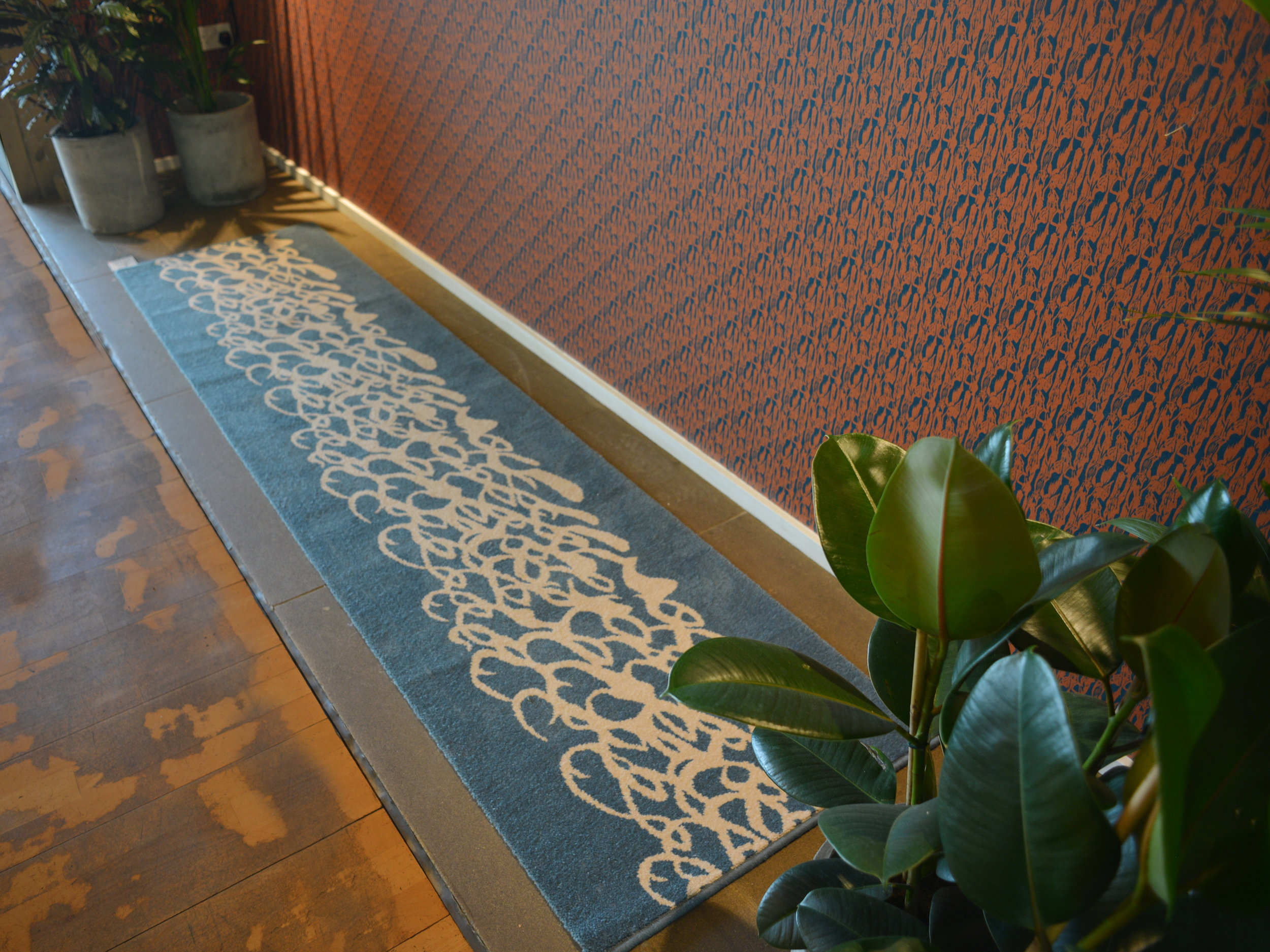
Photo credit: Waterlake Floor Runner, Brushwood Bark Wallpaper. Courtesy of the artist and YSP. Photo © Ella Doran.
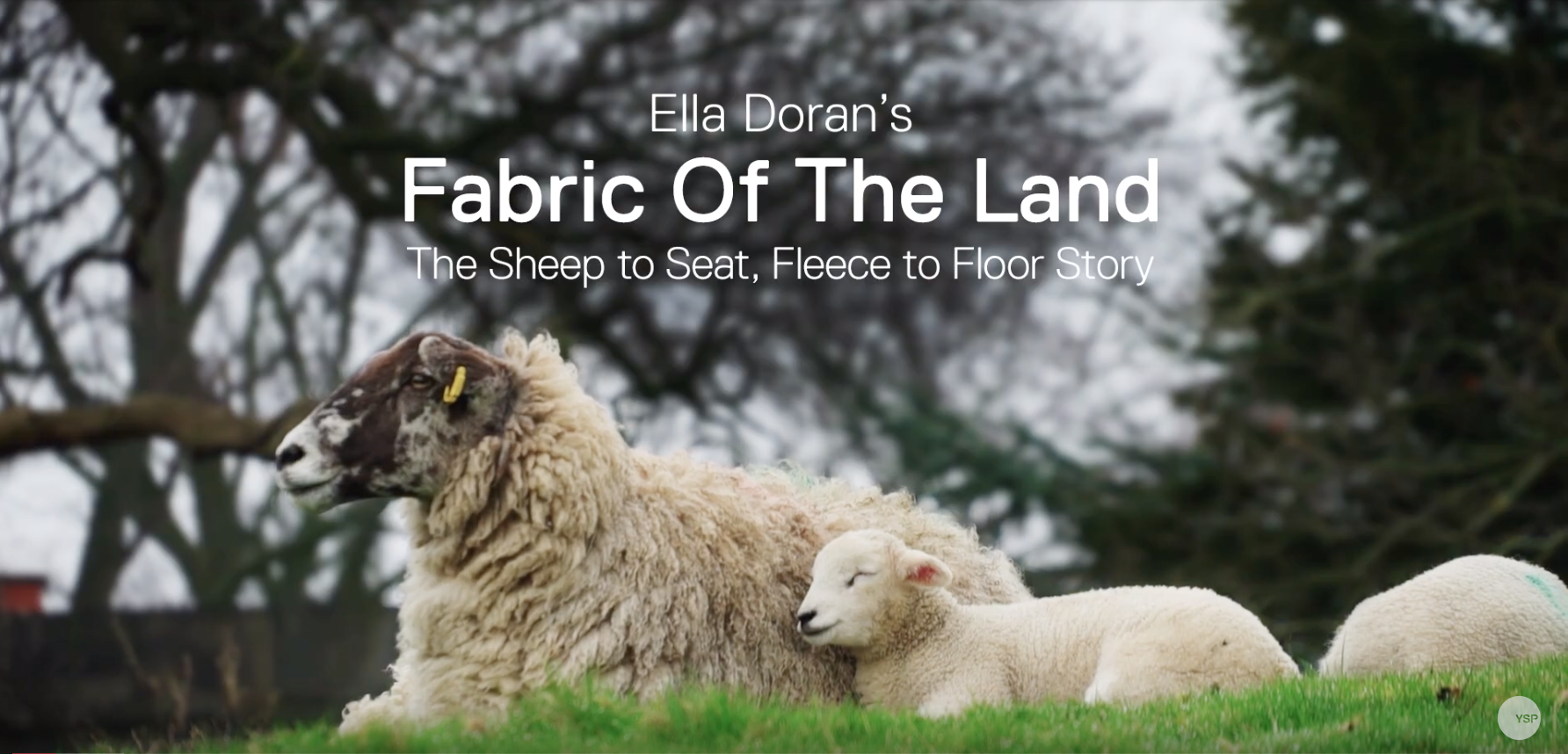
Produced by filmmaker Paul Wyatt, watch the story behind the creation of Ella Doran's exhibition 'Sheep to Seat, Fleece to Floor' for Yorkshire Sculpture Park (YSP) and meet some of the key personalities involved in the journey.

As part of Ella’s exhibition this Summer at Yorkshire Sculpture Park, Alternative Flooring have made a limited edition of carpet runners using with the wool from the sheep that graze at the park. Take a read over on their blog here!
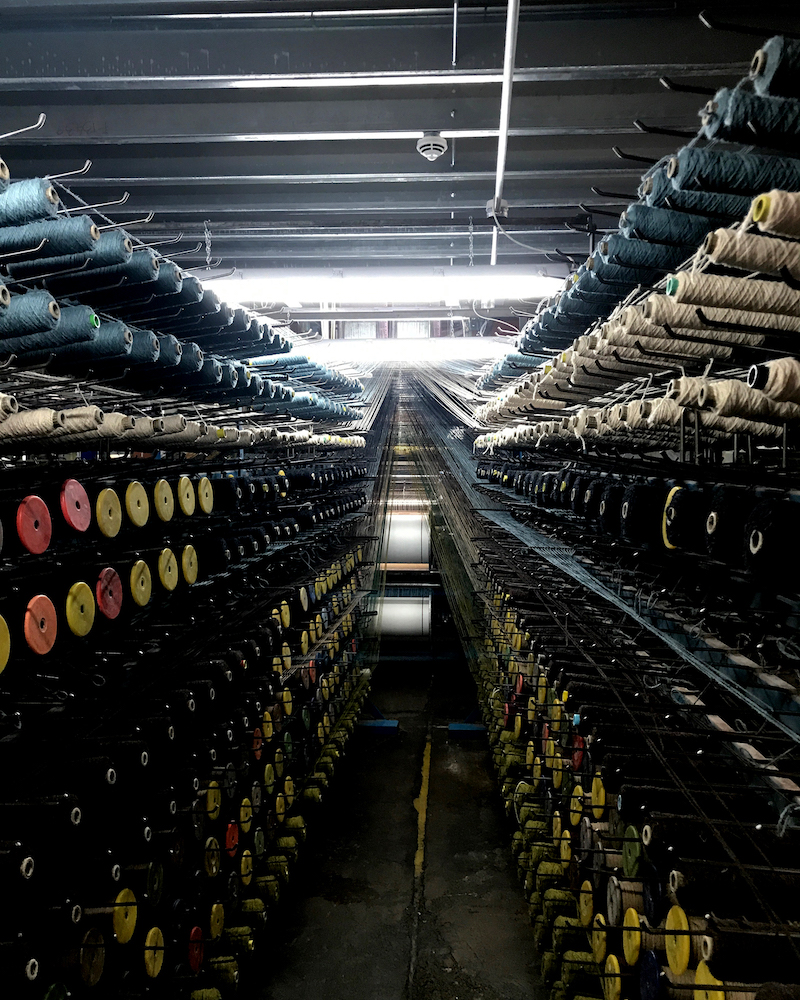
On the loom at Camira.
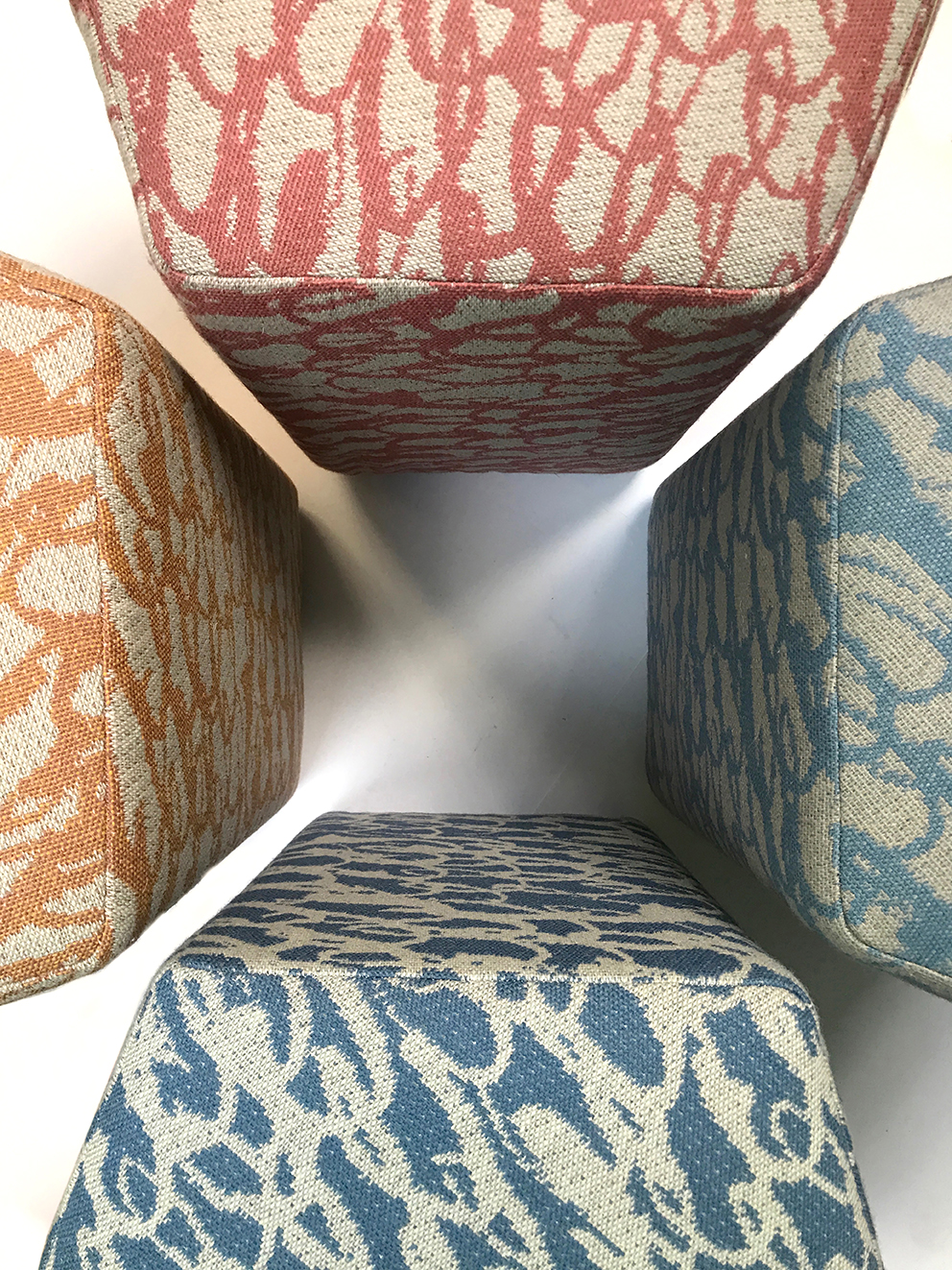
Ella was interview by Jen Isles Marketing Communications Manager for Camira, ahead of her show opening at Yorkshire Sculpture Park next week, to read the full Q&A, visit Camira’s website here.

On the loom at Camira.

You are invited…


Designer and circular economy advocate Ella Doran has collaborated with communications Designer & environmental campaigner Sophie Thomas on a new textile design called ‘Ocean Clean-Up Camo’, which not only draws attention to the huge quantities of discarded plastic in our oceans, but uses it as inspiration for a beautiful, new Textile design.
Sophie Thomas has been beach cleaning and collecting waste plastic for several years, and these particular pieces were washed up by the tide from a favourite beach in Northern Spain. Whilst helping to keep the beach clean, the waste plastics collection also started to evoke something more. ‘The particular rock formation of the area helped make the waste plastic pieces particularly smooth, almost like flat pebbles, whilst maintaining their original colour’, Sophie explained.
The duo created artful arrangements from the plastics, which Ella then photographed, making a textile design from the resulting images, ‘From a distance, the design is reminiscent of a particularly colourful Italian mosaic tile’, Ella said, ‘with the true nature of the objects only visible under close inspection.’
Ella and Sophie both share a passion for the circular economy they hope that the new fabric will help tell the story of plastic pollution. ‘Whilst the end-product is beautiful and has turned non-biodegradable pollutant waste into something positive, the message is still very much that it shouldn’t be there to start with!’ they added. ‘We hope that the life cycle of the new textile will carry that message forward into the future.’

Design Ventura is the Design Museum’s flagship design and enterprise competition for secondary school students in years 9, 10 and 11. Over 13,000 students from 265 across the UK and beyond are registered to take part in 2018, the ninth year of the competition.
The young people are challenged to work in teams design a new product for the Design Museum Shop, responding to a detailed brief. The winning team will work with creative professionals to develop and manufacture their idea and will see it on sale in the Design Museum Shop, with all profits donated to a charity of their choice.
Ella has been invited to help choose the top ten Student teams for Design Ventura this year. The shortlisting involves choosing the top ten ideas from submitted entries and these teams will then be invited to pitch their ideas to a panel of expert judges at the Design Museum in December.
The project is supported by industry experts from the creative industries and business and offers students the chance to develop creative, design thinking, enterprise and transferrable employability skills.
Here’s this year’s brief for the Students given by the lovely Donna Wilson.
Visit the Ventura website
Email ventura@designmuseum.org

From Sheep to Seat, Fleece to Floor follows the journey of sheep wool, from shearing to scouring, design to spinning, to create an exhibition of beautiful bespoke furniture, furnishings and photographic prints, all of which are available to buy. An homage to local products, suppliers and processes, the exhibition highlights the importance of the circular economy in reducing waste and sustaining livelihoods and traditions.
Following a residency at the Park in 2016, which culminated in new product ranges for YSP Shop, Doran worked with the Park’s neighbouring farmer to amass wool from the sheep that reside in the Country Park. After scouring by Haworth Scouring, the wool was transformed by British manufacturers, Camira and Alternative Flooring, and features Doran’s Waterlake design, a distinctive and colourful pattern which mirrors the movement of the lakes and plant life at YSP. The exhibition is accompanied by a short film by Paul Wyatt.
Both British Wool and Campaign for Wool are our project sponsors, along side Camira Fabrics and Alternative Flooring, follow Ella’s journey on instagram @elladorandesigner, as she develops the work, and visit this website for updates and information for the exhibition opening 15th June 2019.
You can watch a short trailer here!


Curated by Barbara Chandler, design editor of Homes & Property at the London Evening Standard
Ella Doran is one of the established designers that forms part of 100% Forward at 100% Design, which will highlight UK emerging design talents, each championed by an established designer who launched their career at 100% Design.
Read More
Ella Doran and Urban Upholstery are joining forces for the London Design Festival 2018 with a collaborative week long events programme and exhibition, at The Old Bank Vault 283, Hackney Road, London, E2 8NA. Saturday 15th September – Sunday 23rd September 2018.
Read More
Ella Doran and Urban Upholstery are joining forces for the London Design Festival 2018 with a collaborative week long events programme and exhibition, at The Old Bank Vault 283, Hackney Road, London, E2 8NA. Saturday 15th September – Sunday 23rd September 2018.
Read More